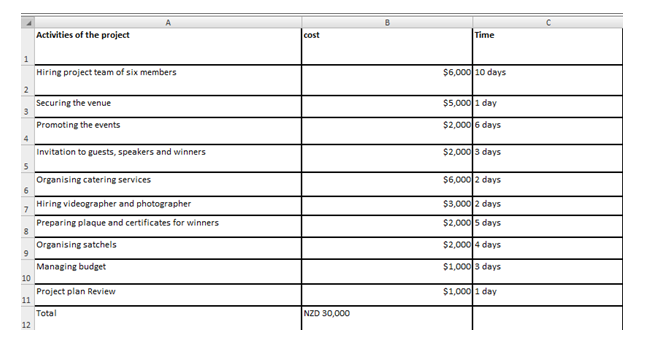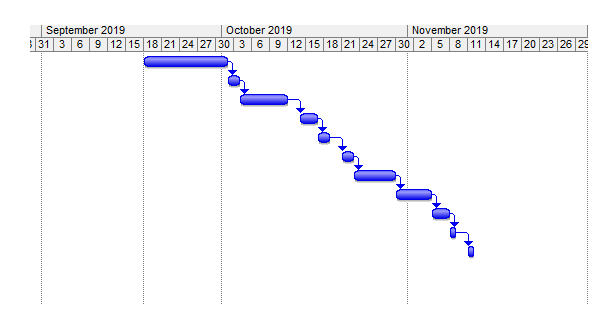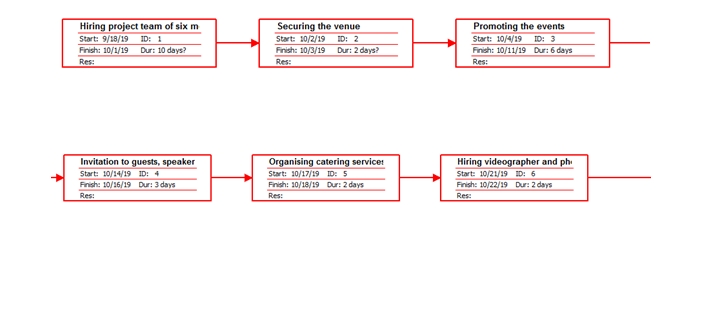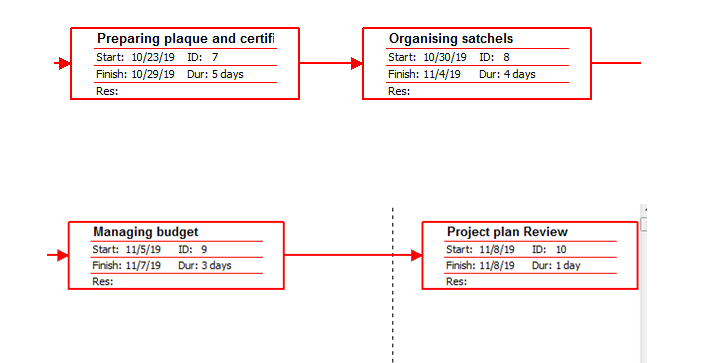[SPORTS RECREATION AWARDS CANTERBURY – 2019]
As stated by Badewi (2016), it is used for reducing project issues by setting work as per priority. In order to complete a project successfully, project manager has to deal with various activities such as arranging resources, hiring employees, setting objective, time and budget. Priority matrix helps in arranging all activities in appropriate order to achieve the expected outcome of the project. In case of Sports & Recreation Awards of Canterbury, priority matrix can help in understanding importance activities of the project. Major activities for the Sports & Recreation Awards are arranging venue, catering services, setting budget, objective, deadline, hiring experienced videographer and photographer, arranging resources, satchels, advertisement and promotion of the event, monitoring project task, managing risk and reviewing project work.
| Task | Cost | Time | Quality | |
| Fixed | · Arranging resources
· Catering services · Advertisement |
$6000 | 18 September 2019 to 10th October, 2019 | High |
| Optimised | · Setting budget
· Setting timeframe · Hiring experts · Selecting venue for the event |
$2000 | 11th October 2019 to 20th October, 2019 | Medium |
| Accepted | · Building relationship with project team
· Focusing on competitors · Monitoring employees’ activities · Managing budget |
$1000 | 21st October 2019 to 10th November, 2019 | High |
Table 1: Project Priority Matrix
(Source: Created by the researcher)
It is observed for the priority matrix that project managers need to understand the differences between significant and urgent tasks. In accordance to Bourne & Weaver (2018), creating a list of project activities can help in setting priority of activities. In the above table, tasks are divided into three parts, fixed, optimised and accepted. Cost is also divided into the priority matrix as per the importance of tasks. It is also required to maintain quality of each activity in order to achieve estimated outcome. In Sports & Recreation Awards, project manager can use this matrix for arranging the activities in appropriate order. According to priority matrix, significant tasks of the project are setting budget, timeframe, selecting venue and hiring experts to complete the task. Advertisement of the event, arranging catering services and other resources are urgent tasks to start the project work. Monitoring activities and performance are necessary for the project; however, these tasks are not urgent. There are also some insignificant tasks such as focusing on competitors for organising event and building relationship with employees. The project can be completed successful by using the priority matrix appropriately.
The study focuses on the project of Sports & Recreation Awards of Canterbury in 2019. This event is organised for the sporting achievement of Canterbury. Evening of the event is special for coaches, officials, teams and administrators. 300 guests are invited for the prestigious event.
The event is represented for acknowledgment and celebration of outstanding sporting achievements for 13 different categories across Canterbury. TVNZ is sponsoring the event and budget is estimated as NZD 30, 000. Event is organised on 18th of October 2019 in Christchurch of the country. A certificate and plaque will be provided to each award winner of sports. Two key note speakers will be available on the day of event for making the event successful. Catering services will be provided to all the attendees such as guests, winners, speakers and project team.
- To promote and advertise the event
- To invite 350 attendees including guests, speakers and winners
- To book Christchurch within $5000 for 3 hours on 18th October 2019
- To organise certificate and plaque for winners
- To organise catering services for 350 people
- To organise satchels for attendees
It is estimated to complete the project within 24th September 2019 within the estimated budget (NZD 30, 000) in order to organise the event successfully on 18th October 2019 properly. Different constraints can be faced during the project work such as changing weather condition and natural disaster, increasing prices of resources and lack of experts to complete the project. Unavailability of Christchurch on the date of event can be the major challenge in the project. Loss can be faced if there is lack of attendees in the event.
Major stakeholders required for the project are project manager sports authority, technical experts, project team, customers and suppliers (Cagliano, Grimaldi & Rafele, 2015). These stakeholders are responsible for successful completion of the project task. In case, any of the stakeholders face difficulties in performing the role, estimated result cannot be achieved. A project team of six members such as Elle, Sunil, Ben, Tom, Ayesha and Aroha, is created for the project task. Tom has the role of project manager to approve all project tasks. Each member of the project team will get a payment of $1000 after successful completion of the event.
WBS is considered as project deliverable used for organising team’ work into managerial sections. As commented by Caron (2015), project manager can divide the complex project into simpler one with the help of work breakdown structure. In the project of Sports & Recreation Awards, Tom has the responsibility to understand different deliverables and phases of the project to complete in appropriate manner. Major phases of the Sports & Recreation Awards project are
- Securing the venue
- Promoting the events
- Invitation to guests, speakers and winners
- Organising catering services
- Hiring videographer and photographer
- Preparing plaque and certificates for winners
- Organising satchels
- Project plan Review

Figure 1: WBS Structure
(Source: Created by the researcher)
With the help of WBS, Tom can arrange the project deliverables in current sequence and assign right responsibilities to each member such as Elle, Sunil, Ben, Ayesha and Aroha. Tom can provide the responsibility to secure venue and promote events to Elle. Invitation and catering responsibilities can be provided to Sunil. Responsibilities to hire videographer and photographer can be provided to Aroha along with managing technical requirement of the venue. Ayesha can be responsible for preparing plaque, satchels and certificates for the winners. Managing overall budget of the project will be the responsibility of Ben. In this way, the event can be organised successful and project team can get the appropriate amount of money as decided.
Resource Allocation Matrix (RAM)
| Name of resource | Designation | Responsibilities | Skill set | Daily rate | Number of working days | Total cost |
| Tom | Project manager | Approve each task and monitor each activity of the project | Management, communication and decision making skills | $100 | 10 | $1000 |
| Elle | Team member of Project | To promote events and secure venue | Marketing and communication skills | $100 | 10 | $1000 |
| Sunil | Team member of Project | Invitation and catering for the event | Communication and event management skills | $100 | 10 | $1000 |
| Ben | Team member of Project | Managing cost of each activity | Cost management skills | $100 | 10 | $1000 |
| Ayesha | Team member of Project | Preparing plaque, satchels and certificates | Event management skills and designing skills | $100 | 10 | $1000 |
| Aroha | Team member of Project | Hiring videographer and photographer and managing technical requirements of the location | Management skills and technical skills | $100 | 10 | $1000 |
Table 2: Resource Allocation Matrix
(Source: Created by the researcher)
This matrix helps in providing responsibilities to each member of project team to complete the project task within expected time (Harrison & Lock, 2017). In the above table, responsibilities of project are provided to members of the team as per her skills and abilities in order to complete the project within time and organise the event successfully on 18th of October 2019 (Sportcanterbury.org.nz, 2019).
| Activities of the project | Responsible person | Required resources | cost | Time |
| Hiring project team of six members | CE of NZ Sports and Recreation | Human and financial | $6000 | 10 days |
| Securing the venue | Elle | Human and financial | $5000 | 1 day |
| Promoting the events | Elle | Human and financial | $2000 | 6 days |
| Invitation to guests, speakers and winners | Sunil | Human and financial | $2000 | 3 days |
| Organising catering services | Sunil | Human and financial | $6000 | 2 days |
| Hiring videographer and photographer | Aroha | Financial resource | $3000 | 2 days |
| Preparing plaque and certificates for winners | Ayesha | Financial resource | $2000 | 5 days |
| Organising satchels | Ayesha | Financial resource | $2000 | 4 days |
| Managing budget | Ben | Human resource | $1000 | 3 days |
| Project plan Review | Tom | Human resource | $1000 | 1 day |
| Total | NZD 30,000 |
Table 3: Precedence and Duration table
(Source: Created by the researcher)

Figure 2: Calculation of total cost
(Source: Created by the researcher)

Figure 3: Gantt chart
(Source: Created by the researcher)
Precedence and Duration table help project managers to complete each task of the project within estimated budget and time. As stated by Kerzner (2017), dividing the cost for each activity can help in reducing risk of exceeding project budget. This table also helps in performing each project work properly within estimated date s that project can be completed within deadline. Sports & Recreation Awards event can be organised on the estimated date with the help of this table.
Sequence activities of project management are represented in the form of network diagram. Project activities are visualised in boxes aong with interrelationship between the activities. In accordance to Kivilä, Martinsuo & Vuorinen (2017), it helps in completing each activity of the project within estimated time. Project manager can plan, organise and control entire project tasks with the help of Network diagram. Project duration can be created with this diagram. Project manager of Sports & Recreation Awards can avoid the risk of exceeding deadline with the help of Network diagram. Interdependencies of activities of the project can be understood using network diagram for the sports project. Work flow of project activities is shown in the network diagram of the sports project. Progress of the project can be estimated with the help of this network diagram.


Figure 4: Network Diagram
(Source: Created by the researcher)
Above network diagram of Sports & Recreation Awards helps in understanding various project activities in sequence manner. Relationship among various activities can be understood with the help of arrows between the activities. Project progress of the sports project can be understood with the help of this network diagram.
Stakeholders’ analysis is an important technique for identification of stakeholders for a particular project along with their requirements from the project (Lehnert, Linhart & Röglinger, 2016). Various stakeholders for the project of Sports & Recreation Awards are project manager sports authority, technical experts, project team, customers and suppliers. Project team includes six members of the project such as Elle, Sunil, Tom, Ben, Ayesha and Aroha. Other stakeholders of the project are videographer, photographer, speakers, catering team, technical team, winners and guests. All stakeholders have interest in the project work. Stakeholders’ management processes are identification of stakeholders, documentation of their requirements, analysing their interest, managing their expectations, taking action and reviewing status. The purpose of stakeholders’ analysis is to develop strategic view of institutional and human landscape. In accordance to Marier-Bienvenue, Pellerin & Cassivi (2017), relationship between various stakeholders can be understood by performing stakeholders’ analysis. Projects risks can be avoided by performing stakeholders’ analysis in appropriate manner. As commented by Samset & Volden (2016), meeting the needs of stakeholders can help in completing the project successfully. Project manager has the responsibility to manage the relationship among various stakeholders of Sports & Recreation Awards. In order to complete the project successfully, it is necessary for project manager to have proper communication with the team. Project risks can be easily identified if all stakeholders play their responsibility appropriately in the project.
| Stakeholders | Method of communication | Frequency | Objective |
| Project team | Email, message | daily | T complete each activity appropriately for successful completion of the project |
| Speakers | Email, through mobile phone and face to face | weakly | To invite them in the event to make it successful and knowledgeable |
| Audience | Face to face | In the event | To increase the value of Sports & Recreation Awards |
| Catering team
|
Face to face, messages and email | daily | To provide appropriate catering services to audience to make the event successful |
| Technical team
|
Email, through mobile phone and face to face | daily | To avoid technical difficulties in the event to make it successful |
| Videographer and photographer | Email, through mobile phone and face to face | daily | To record the event appropriately for future benefits |
Table 4: Communication plan
(Source: Created by the researcher)
Communication plan is necessary to involve each stakeholder of the projects appropriately in the project tasks (Meyer et al. 2016). It can be helpful for the project of Sports & Recreation Awards to complete each task properly to achieve estimated outcome of the project and complete to within deadline and estimated cost. The event can be successfully organised on 18th of October 2019 by using the communication plan properly during project tasks.
Badewi, A. (2016). The impact of project management (PM) and benefits management (BM) practices on project success: Towards developing a project benefits governance framework. International Journal of Project Management, 34(4), 761-778. Retrieved from: https://s3.amazonaws.com/academia.edu.documents/39254205/1-s2.0-S0263786315001027-main.pdf?response-content-disposition=inline%3B%20filename%3DThe_impact_of_project_management_PM_and.pdf&X-Amz-Algorithm=AWS4-HMAC-SHA256&X-Amz-Credential=AKIAIWOWYYGZ2Y53UL3A%2F20190918%2Fus-east-1%2Fs3%2Faws4_request&X-Amz-Date=20190918T053606Z&X-Amz-Expires=3600&X-Amz-SignedHeaders=host&X-Amz-Signature=91421071d22eab08737bd8de576e3b2cc62bc4822673b0a801cd68bd7d3d1a04
Bourne, L. M., & Weaver, P. (2018). The origins of schedule management: the concepts used in planning, allocating, visualizing and managing time in a project. Frontiers of Engineering Management, 5(2), 150-166. Retrieved from: https://mosaicprojects.com.au/PDF_Papers/P202_The_Origins_of_Schedule_Management.pdf
Cagliano, A. C., Grimaldi, S., & Rafele, C. (2015). Choosing project risk management techniques. A theoretical framework. Journal of Risk Research, 18(2), 232-248. Retrieved from: https://s3.amazonaws.com/academia.edu.documents/40432054/Choosing_project_risk_management_techniq20151127-28121-prwcjz.pdf?response-content-disposition=inline%3B%20filename%3DChoosing_project_risk_management_techniq.pdf&X-Amz-Algorithm=AWS4-HMAC-SHA256&X-Amz-Credential=AKIAIWOWYYGZ2Y53UL3A%2F20190918%2Fus-east-1%2Fs3%2Faws4_request&X-Amz-Date=20190918T053338Z&X-Amz-Expires=3600&X-Amz-SignedHeaders=host&X-Amz-Signature=68709e4476cd9db2c29a60127eea64caae269e050718aaab4b19a4516b3c3abc
Caron, F. (2015). Data management in project planning and control. International Journal of Data Science, 1(1), 42-57. Retrieved from: https://re.public.polimi.it/retrieve/handle/11311/964392/50351/IJDS%201104%20Caron.pdf
Harrison, F., & Lock, D. (2017). Advanced project management: a structured approach. Abingdon: Routledge.
Kerzner, H. (2017). Project management: a systems approach to planning, scheduling, and controlling. New Jersey: John Wiley & Sons.
Kivilä, J., Martinsuo, M., & Vuorinen, L. (2017). Sustainable project management through project control in infrastructure projects. International Journal of Project Management, 35(6), 1167-1183. Retrieved from: http://e-tarjome.com/storage/panel/fileuploads/2019-02-20/1550663922_E10656-e-tarjome.pdf
Lehnert, M., Linhart, A., & Röglinger, M. (2016). Value-based process project portfolio management: integrated planning of BPM capability development and process improvement. Business Research, 9(2), 377-419. Retrieved from: https://link.springer.com/article/10.1007/s40685-016-0036-5 [Accessed on: 29 May 2019]
Marier-Bienvenue, T., Pellerin, R., & Cassivi, L. (2017). Project planning and control in social and solidarity economy organizations: a literature review. Procedia computer science, 121, 692-698. Retrieved from: https://pdf.sciencedirectassets.com/280203/1-s2.0-S1877050917X00203/1-s2.0-S1877050917322901/main.pdf?X-Amz-Security-Token=AgoJb3JpZ2luX2VjEL3%2F%2F%2F%2F%2F%2F%2F%2F%2F%2FwEaCXVzLWVhc3QtMSJHMEUCICPU%2BYK2EVH8Uo5qWkwKKWXJjnz%2F2VC9MI%2BJggy0F4KJAiEA7NfjmRZuAVao1Fx2D6ppmq0R9blwvB8bu1UGDXgwSDcq4wMIhv%2F%2F%2F%2F%2F%2F%2F%2F%2F%2FARACGgwwNTkwMDM1NDY4NjUiDIno2vJSuKjUQX%2BjJiq3A7aPJgkFPRVz4yIYXaYb2J1sT4kQ4l1%2B0tKvJqOMLu2uR%2FHFW%2BXAb8bbM1PqHLmTfiXu%2B0HzzDNA4IWNd2Df86hkGsynFSzsR1jtGNu5hqvl3Hw9mN9rZnLSLbid4oY9yupMIcMCk77fp%2F2N2ypmHuxjKserGhQ6kKtrC0skWCDRQzfKvBmAz78iLWlh4K3VMsKY9p4QHQGur19p3v8fDX5jtz8D3BV6Q8WG2534R1kTZTKACTmQHeJ2If8sWGgo8RF3Sh4huCtqhyGXh48XJdlSez37TV6O9NJ6IeMXMb%2FDFAov%2FbccPfmFwkFmqsf%2FhY%2Bs%2BcmPDcdsFa4WvIht2zrvzo%2Bxt75l3R3Nqg9eusdbZWBAkK%2FEGSf%2Bs7aLlbmgztRDO9Ec1nEVxIW4Zru4jB0Icq%2BGxmleHDK8Xx9vckhYG3AdZv1oHeMyhgqttHn%2FOYO87wW9nvbHb1RHX6RHjo12uCu2onVTFA9WroI0CfP066cR4cWiVwUyWVp6IUuHt95%2B5ke%2B2UB8rPWt6E9P0Qoh1qafnLYGdpzckTLNhaxn%2FErxviqZz1cnfvl860C8JccpFa21DSMw%2FeuG7AU6tAFuFXQAShSR2XtDCQ%2FWyFII3Nx4xNUzch5gPBuyKRHdezfDYhLqzQtSFBvSgdSB9Cuq71Ymr64YJ4NjKc8W%2FE7XX8bqOy0J5B14ZfEbH0T7MXrUPe2O6X4ugoTtHUfyvXW2UktmvA5I67P4IgcGujMR7EJkNHS0pEoNk%2FaxOXg22NGLjkErcKRDRB%2BN6SlMYY2VEEKKu6xrBQ6bl5nLsCiiQa1GoZxIuB%2FV22Eyxq6UZFcW0Xg%3D&X-Amz-Algorithm=AWS4-HMAC-SHA256&X-Amz-Date=20190918T053705Z&X-Amz-SignedHeaders=host&X-Amz-Expires=300&X-Amz-Credential=ASIAQ3PHCVTY2UNOA4FW%2F20190918%2Fus-east-1%2Fs3%2Faws4_request&X-Amz-Signature=59de9e33ab38821a5be8142fc7a542b3a825bc2d4aa1be5a61ac8d8cca6e115d&hash=714893d41bb213ea74f1195ebd34043689ae7635fc0130f320e16e7e3364a45c&host=68042c943591013ac2b2430a89b270f6af2c76d8dfd086a07176afe7c76c2c61&pii=S1877050917322901&tid=spdf-c77c9f03-dcbe-463c-8b34-cc3beab1c450&sid=45b3c9b76aa33848cd0acfa49505c856d0fagxrqa&type=client
Meyer, W. S., Bryan, B. A., Summers, D. M., Lyle, G., Wells, S., McLean, J., & Siebentritt, M. (2016). Regional engagement and spatial modelling for natural resource management planning. Sustainability science, 11(5), 733-747. Retrieved from: https://link.springer.com/article/10.1007/s11625-015-0341-5 [Accessed on: 29 May 2019]
Samset, K., & Volden, G. H. (2016). Front-end definition of projects: Ten paradoxes and some reflections regarding project management and project governance. International Journal of Project Management, 34(2), 297-313. Retrieved from: https://sintef.brage.unit.no/sintef-xmlui/bitstream/handle/11250/2589062/Peter%20Morris%20Festschrift%20-%20Front-end%20definition%20and%20ten%20paradoxes%20-%20FINA….pdf?sequence=4
Sportcanterbury.org.nz (2019), Project event, retrieved from: https://www.sportcanterbury.org.nz/Events/ORIX-NZ-Canterbury-Sports-Awards [Accessed on: 29 May 2019]



I’m gone to tell my little brother, that he should also go to see this blog on regular basis to obtain updated from latest information.
https://suba.me/